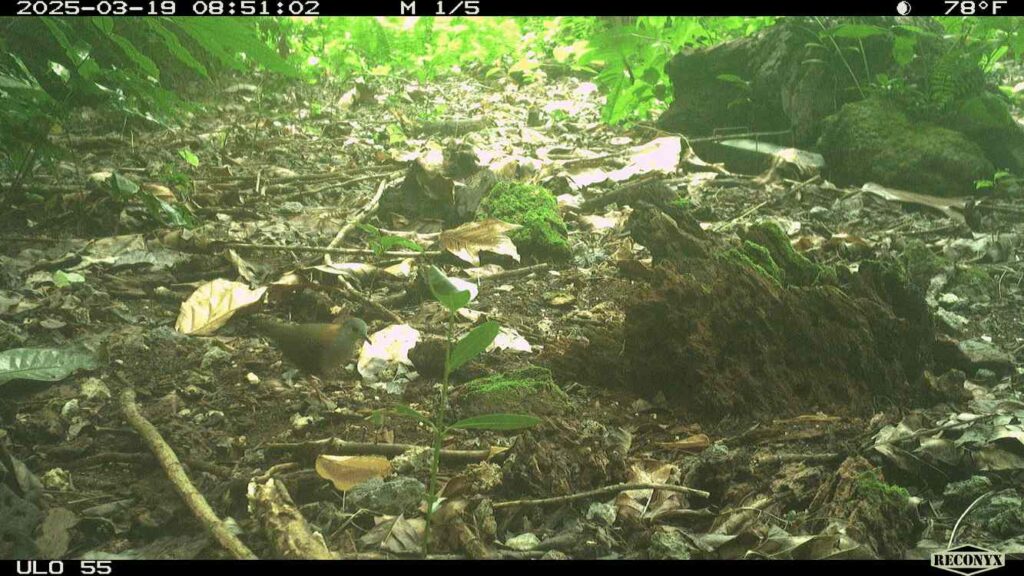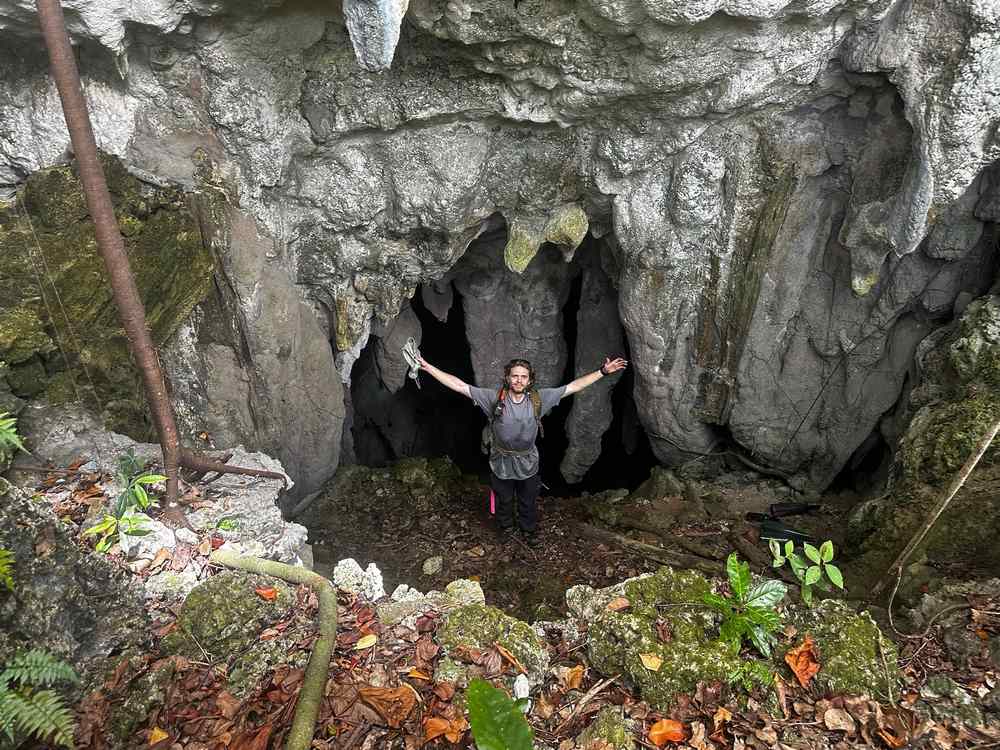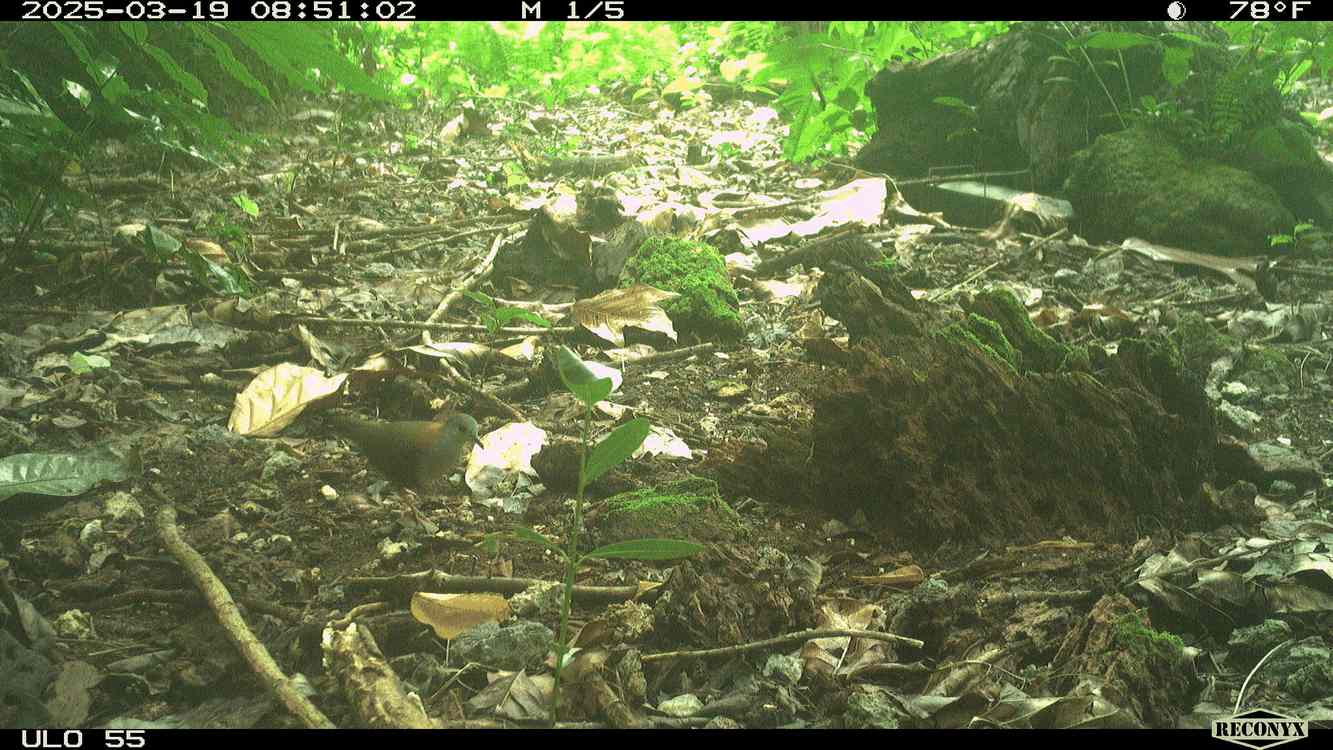 Ulong Island beaches – credit, Matt Kieffer CC 2.0. Wikimedia
Ulong Island beaches – credit, Matt Kieffer CC 2.0. Wikimedia
Native species like the Endangered Palau ground dove have significantly increased in number thanks to a successful restoration campaign on Ulong Island in Palau.
Working together in 2023-24, government agencies advised and assisted by the NGO Island Conservation, removed damaging invasive rats which devoured native bird eggs and young, decimated native plant populations through seed predation, preyed on native crabs, and disrupted food webs—ultimately threatening ecosystem collapse.
 Endangered Ground doves safely exploring the forest floor – Credit, Island Conservation
Endangered Ground doves safely exploring the forest floor – Credit, Island Conservation
Now, after one full year of rigorous monitoring—including trail cameras, eDNA sampling, and field surveys—the partners confirmed no invasive rodents remain on the island. This success marks a monumental step forward for conservation in Palau, the Micronesia region, and across the Pacific.
Located due north of the eastern group of Indonesian islands, Palau is made up of 340 islands totaling 466 square miles of land area. Ulong is located in the western waters of the archipelago, and is considered one of the best diving spots on Earth.
Ulong, where little human habitation exists, and which for all the world seems like the perfect tropical paradise, was nevertheless infested with rats brought there by ships. The doves were sitting ducks (or sitting doves) for the rats, which could get at their young and their eggs with ease.
With the pressure of invasive species removed, however, signs of recovery in this unique ecosystem are already emerging. Island Conservation’s monitoring team noticed a higher incidence of ground doves, including sightings of chicks at landing sites where they were never previously recorded.
“The results are thrilling,” shared Coral Wolf, Island Conservation’s Impact Program Manager who conducted monitoring on the island over a three-year period, starting in 2022. “We’re seeing and hearing recovery: since the program began, we’ve recorded a significant increase in calls from brown noddies, white terns, and bridled terns. This increase occurred just one-year post-eradication—who knows what recovery remains to be discovered!”
 Austin Hall, Island Restoration Specialist at Island Conservation, in front of a cave on Ulong – Credit, Island Conservaton / Coral Wolf
Austin Hall, Island Restoration Specialist at Island Conservation, in front of a cave on Ulong – Credit, Island Conservaton / Coral Wolf
These early indicators of success can be expected to cascade into the surrounding marine ecosystem, which will benefit from repaired nutrient flows between land and sea.
Acoustics data shows a dramatic increase in bird calls across the project site. Trail cameras also captured footage of Endangered Palau ground doves safely navigating the forest floor, fear from persecution by the rats.
MORE OF ISLAND CONSERVATION’S WORK:
As well as the pristine beaches and reefs, Ulong is also home to precious artifacts of pre-colonial indigenous culture. Its ancient caves contain paintings and pictographs signifying beliefs and activities that far preceded colonialization. These treasured cultural sites are couched in an equally priceless, finely tuned ecosystem, home to many rare species.
Tourists and their guides have also noticed the difference. Camping outings on Ulong Island have become more enjoyable, with fewer disruptions and a renewed sense of connection to the island’s natural beauty and cultural history. To safeguard this progress, the partners implemented a robust biosecurity protocol to prevent reinvasion and protect the long-term conservation investment.
“Conservation has always been central to Palau’s identity, and here in Koror, we’ve seen how it strengthens both our ecosystems and our way of life,” a spokesman for the Koror State Government, under which Ulong is administered, said in a statement. “The restoration work on Ulong is a shining example of what’s possible—not just for our community, but for others across the Pacific who share our commitment to protecting island environments.”
Island Conservation, whose work GNN has reported on consistently over the last we years, is currently analyzing monitoring data, including seabird point counts, camera trap footage, and stable isotope samples. These findings will be integrated into a broader island-ocean context in collaboration with Scripps Institution of Oceanography, with full initial results expected by early next year.
“This project shows the world what’s possible when a partnership of culture, conservation and innovation unite.” said Tommy Hall, Project Manager at Island Conservation. “Seeing endangered species rebounding so quickly reminds us that nature is resilient; and with biosecurity securing the future, Ulong Island stands as a beacon of success for Pacific islands.”
SHARE This Latest Island To Be Restored To Native Glory With Your Friends…

